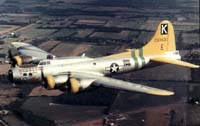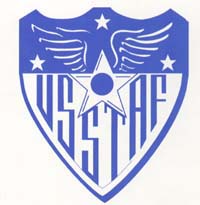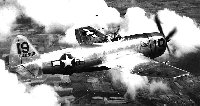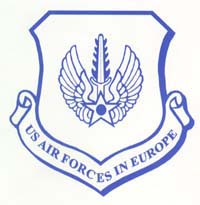 |
 |
 |
The USAAF in World War II The story from 1942 to 1945 The Beginning and the Strategy On 7th December 1941 the Japanese attacked Pearl Harbour in Hawaii and the USA then entered the War. The UK and its Empire had already been at war since September 1939 and there had been contingency plans already drawn up with the Americans as to how the USA might participate. On 28th January 1942 the Eighth Air Force was activated in Savannah, Georgia. At first it was intended to be part of the invasion of North West Africa but that idea was soon postponed. Then the 8th became part of Bolero, the buildup of US forces in the UK to attack Europe and prepare for a cross channel invasion in 1943. |

|
In the late 1930's it was believed that heavily-armed bombers would always be able to penetrate enemy defences and by destroying installations behind the enemy's advance he would quickly become unable to wage war. Boeing had developed a revolutionary four engined heavy bomber to meet military specifications and this became known as the B-17 Flying Fortress. It was to
be the weapon which the USAAF relied on to press forward with its strategy of daylight high altitude precision bombing by unescorted, but heavily armed, bombers. By 1942 the RAF had given up daylight bombing because of heavy losses inflicted by fierce German defences, and so advised the USAAF against this strategy. Nevertheless, the Combined Bomber Offensive was agreed, and while RAF Bomber Command flew at night, the USAAF resolved to fly by day. 1942 In February 1942 the first USAAF HQ was established in Europe at Daws Hill, High Wycombe, and in June the 8th AF HQ was set up in Bushy Park, London. The first US plane landed in Britain on 1st July 1942 - a B-17. The first official wartime attack by US air personnel was carried out on 4th July. The 15th Bomb Squadron flew 6 RAF Bostons along with 6 British crews in an attack on enemy airfields in the Netherlands. The first 8th AF attack with its own planes was to come on 17th August 1942 when 12 bombers of the 97th Bomb Group attacked Rouen-Sotteville rail yard in France.
Until well into 1943 the 8th AF was still too weak to make any significant impact but it continued to build up its resources through 1942. 1943 There was also a period when resources were committed to attacking U-boat pens, bases and construction yards. Attacking the yards brought no immediate relief for North Atlantic convoys and attacking the pens turned out no discernible results because of deep, thick concrete, emplacements. It was estimated that two-thirds of the USAAF bombs dropped from January to June 1943 were on these targets and did no damage to the enemy. By Summer 1943 the North African campaign was over and the buildup in Britain was renewed. Targets were switched to the aircraft, ball bearing and oil production centres. Unfortunately enemy defences had also been reinforced so that by the end of 1943 there were three times as many fighters opposing the 8th AF than there were in January 1943. The Luftwaffe were also constantly inventing new tactics to damage the bomber formations.
In mid 1942 38% of German fighters were on the western front but by Spring 1943 this rose to 45%. The Eastern front figures for the same period fell from 43% to only 27%. Schweinfurt and Regensburg
One year after that first raid on Rouen a massive two-pronged attack was mounted against Schweinfurt, where half of Germany's ball bearings were produced, and the Regensburg Messerschmitt factory. On 17th August 1943 the 1st and 3rd Bomb Divisions launched 367 B-17s and faced almost continuous opposition on route. The 3rd Division bombed Regensburg and then flew south over the Alps to North Africa. This was known as a "shuttle" raid. Air Superiority is Gained
Such losses were unsustainable and these deep penetration raids were stopped. However enemy fighter production had been cut in half and Luftwaffe turnover was 150% in 1943 with 3,000 trained pilots lost. Their average battle strength was 2,100 pilots and machines. It is possible to
see from today's perspective that the Luftwaffe was now declining in numbers and quality whilst the vast fully mobilised and attack-free American economy was still turning out B-17s and B-24s in growing numbers. By 1943 the USAAF knew that the bombers needed fighter escorts and efforts were extended to increase their range. External droptanks were added to the P-47s. In late 1943 the P-38s and P-51s with drop tanks arrived in numbers, and these could reach Berlin and back. On 3rd November 1943 the 8th AF flew its first 500 bomber raid and devastated the port of Wilhelmshaven. By 13th December they could send 649 bombers to Bremen, Hamburg and Kiel, and 763 to Frankfurt in January. |
 |
1944 In 1944 the bombing effort was switched to the enemy airforce itself. The 15th Air Force was set up in Italy to attack Germany from the south, and the United States Strategic Air Forces in Europe (USSTAF) was set up based on the 8th AF and encompassing the 15th AF in February 1944. USSTAF's aim was to destroy the Luftwaffe and prevent it from hindering Operation Overlord, the invasion of Europe. This reorganisation allowed co-ordination of American airpower over the whole European theatre of war. This was in marked contrast to the Luftwaffe whose command was divided between France and Germany. Big Week - build up to invasion
USSTAF's opening move was the "Big Week" of 19th to 25th February 1944 when the 8th AF and 15th AF combined in heavy attacks on German aircraft factories. The long range fighter escorts no longer stayed with the bombers but strafed airfields and sought out the enemy. The Luftwaffe suffered terrible losses. In February 1944 they lost 33% of available aircraft. In March they lost 56% of the planes available as at the 1st of the month; in April 43% and in May 50%. A total of 2,000
Luftwaffe pilots were lost over these months. In mid March 1944 the tactical fighter-bomber units of US 9th Air Force and RAF 2nd Tactical Air Force began a series of attacks on Belgian and French rail yards. In late May the fighters began "Chattanooga Choo-Choo", an operation to destroy rolling stock in France, Belgium, Germany and as far east as Poland. This was all as a prelude to invasion, to cut enemy supply lines and finally, a week before D-Day, every Seine crossing from Paris to the sea was destroyed. The USSTAF Bombers, RAF Bomber Command and light bombers also attacked every airfield within 350 miles of the invasion zone, rendering them nearly unusable in the last weeks before D-Day. The Luftwaffe pulled back its fighters to defend Germany, and when they tried to re-deploy after the invasion this was now almost impossible, and so played little part in the campaign. Allied airpower was also crucial for reconnaisance of enemy positions and denying reconnaisance information over the British coast to the enemy. For the first half of 1944 only 32 German planes crossed the British coast in daylight. D-Day
On June 6th 1944 D-Day began with 3 air borne divisions of 24,000 men dropped around beachheads. Bombers dropped 10,000 tons of bombs on coastal defences just before landing craft hit the beaches and the fighters attacked artillery and troop positions. The 8th AF and 9th AF had 3,000 planes in the air, and only two enemy planes got through to the beachheads. In mid June 1944 the V1 missiles were launched against London from northern France and both US and RAF bomber commands devoted considerable efforts to destroy their bases. By September the V2s were also in use. |

|
On 25th July the allies broke out from the beachhead and as the tank columns crossed France they were able to call upon close support from the P-47 Thunderbolts of the 9th AF. By mid September, the ground attack had reached the Rhine and some bombers were switched back to strategic bombing of Germany. In fact 70% of the bomb tonnage dropped in Europe and the Mediterranean was delivered after D-Day. On 24th December a 2,000 bomber raid on German airfields led to the death of the 4th Bomb Wing Commander, General Castle. The code breakers at Bletchley Park had discovered that the Germans were concerned with their oil supplies, so USSTAF concentrated on refineries and fuel plants. 1945 Then the bombing was turned on the roads so that the transport network was devastated and German industrial production plummeted. By February 1945 Allied air power was so overwhelming that thousands of tons of bombs were dropped on Berlin and on 13th, 14th and 15th the fearful firestorm of Dresden resulted in over 35,000 deaths. Final Victory
|
|
On 7th May 1945 the Germans surrendered in Reims and all this air power was available to move to the Pacific. In June 1945 the 8th AF relocated there. On 14th August the Japanese surrendered. On 7th August the USSTAF was renamed US Air Forces in Europe by deleting the word "Strategic" from its name. At this time the USAFE had 17,000 aeroplanes and 450,000 personnel and following the demobilisation this fell to 450 planes and 18,000 personnel by the end of 1947. The Eighth Air Force alone lost 26,000 men in action, although the exact numbers cannot be known. What is sure are the memories left behind in East Anglia after an intense three years of operations, by men who are still remembered with deep respect and affection to this day. | |
 |
American Military Connections - 1945 to Present Day
The Post War USAFE in Context
In February 1944 the Eighth Army Air Force was assigned to the newly designated US Strategic Air Forces in Europe or USSTAF to acknowledge the widening theatre of war beyond bases in mainland Britain. USSTAF HQ was set up at Bushey Park and also covered the Fifteenth Air Force in Italy.
In 1945 Joseph Stalin pronounced that any freely elected governments in Poland, Czechoslovakia and other Eastern European states would be anti-Soviet and he refused to allow this. In March 1946 Winston Churchill referred to an iron curtain descending across the continent. The cold war began because of this struggle for control of the politics of these nations. This conflict extended to the future of Germany, and the Soviet Union blockaded all surface transport into West Berlin in June 1948. Gradually there was a massive build up of an airlift of supplies into that city through until September 1949, although the blockade was officially lifted in May 1949.
In April 1949 the North Atlantic Treaty was signed which committed the USA to defend Europe against Soviet attack. At first NATO relied on US Strategic Air Command to deter such an eventuality but in 1950 the start of the Korean War led to European re-equipping and consideration of the deployment of tactical nuclear weapons. In 1953 Eisenhower introduced his new look strategy which came to mean that any aggression by USSR would be met by a massive retaliatory response using nuclear weapons. In May 1955 Moscow formed the Warsaw Pact, and that year the first B57 atom bomb capable planes were introduced to 38th Bomb Group. In 1958 the Thor intermediate range missile first arrived in the UK.
In August 1961 the Berlin Wall was built and stood for 28 years. With subsequent defence cuts bases were closed in Britain and Europe, and between March 1966 and April 1967 all NATO forces were ordered out of France.
With President Kennedy in power the old "trip-wire" strategy which could have resulted in massive nuclear war was replaced in 1961 by "flexible response." In 1965 modernisation resulted in the F4 Phantom which was to be the fighter workhorse into the 1980's; the last one not leaving Europe until 1994.
In 1970 the swing wing F111E was supplied to its first unit, the 20th Tactical Fighter Wing.
In August 1968 the Warsaw Pact invaded Czechoslovakia, and their air power was increased by the introduction of the Mig 25 in great quantity. But by 1972 USAFE aircraft strength was down to 658, and was now slowly increased as the 1973 Yom Kippur war proved the value of combat readiness, air base defence and advanced technologies. |

|
In 1973 the USAFE HQ moved from Lindsay to Ramstein in Germany, where it remains today. In 1976 the F15's were introduced and in 1977 48th Tactical Fighter Wing adopted the F111F with "Pave Tack" precision guidance systems. In 1978 the first A10's arrived as a tank buster. In December 1979 Russia invaded Afghanistan leading to further NATO modernisation. The first F16's arrived in 1981 and the Ground Launched Cruise Missiles (GLCMs) were deployed throughout the 1980's to counter the Soviet SS20 missile with its 3,000 mile range.
In 1987 Ronald Reagan and Mikhail Gorbachov signed a treaty to eliminate intermediate range nuclear forces and from 1988 to 1991 all the GLCM wings were inactivated.
Meanwhile, violence was escalating in the Middle East with a series of terrorist attacks culminating in a retaliatory response against Libya in April 1986.
The word Tactical was omitted from all unit designations in October 1991. Despite other conflicts in Yugoslavia, Zaire, Sierra Leone and Liberia from 1990 onwards the USAFE is once again being downsized but there is some modernisation. The F15E joined the 48th FW from February 1992 and by Summer 1993 all 48 were installed at Lakenheath. F16's were deployed from 1993. In 1997 the United States Air Force celebrates its 50th anniversary and USAFE celebrates its 55th birthday. Local celebrations at Mildenhall in August featured a veterans reunion, a chance to view the Sally B (B17 Bomber), P51 Mustang and P47 Thunderbolt and vehicles of the period supplied and driven by the Suffolk Branch of the Historic Military Vehicles Society. |
| Go to American Connections | Updated 6 October 2004 | Go to Home Page |